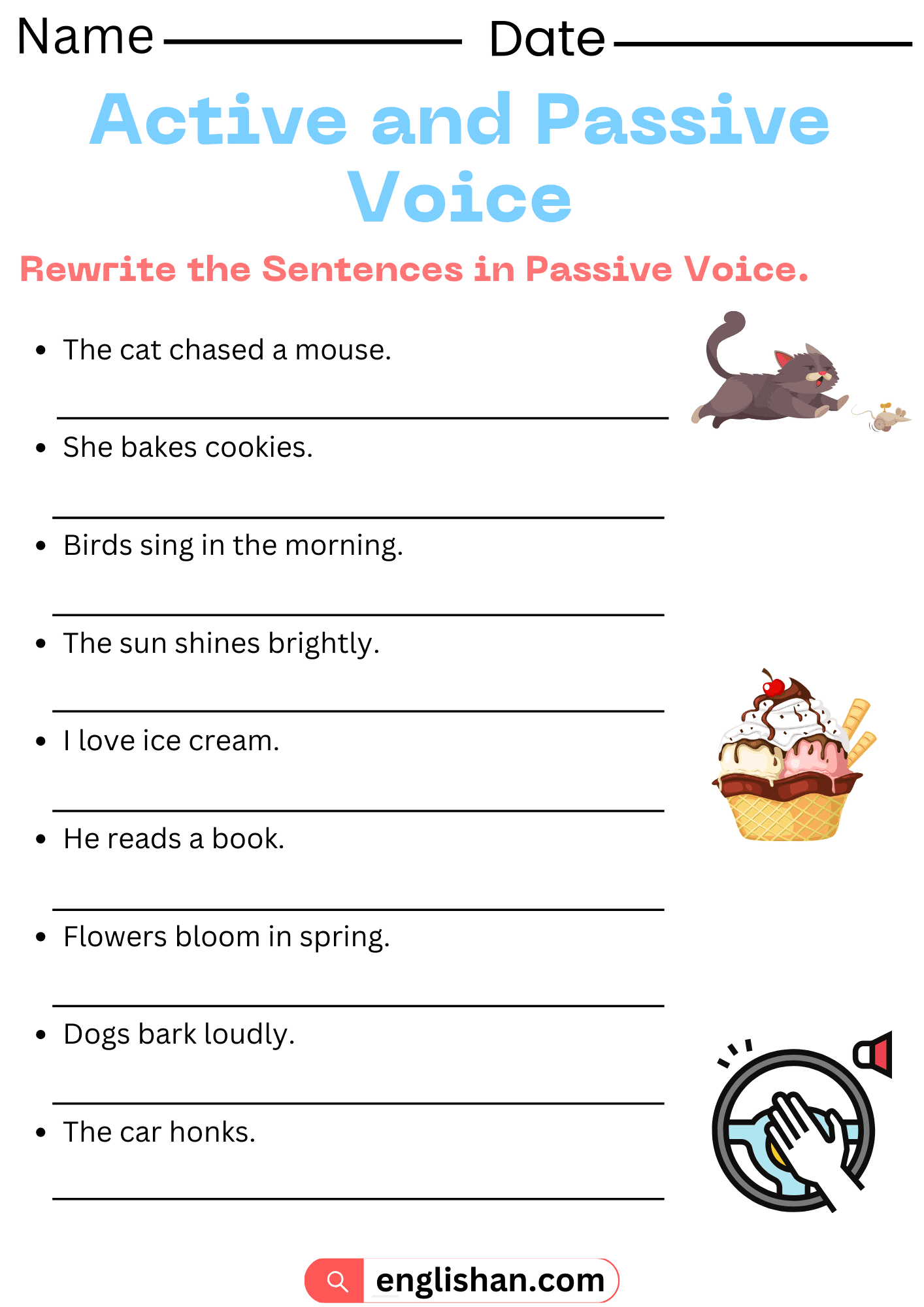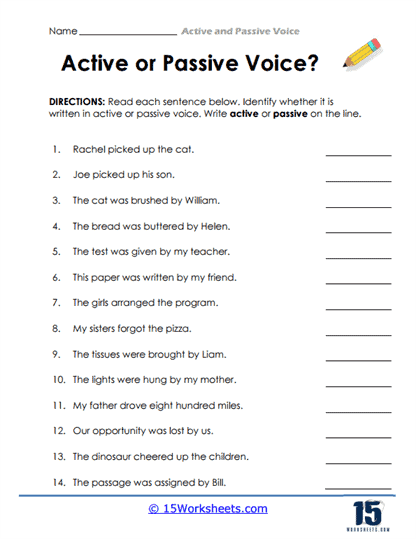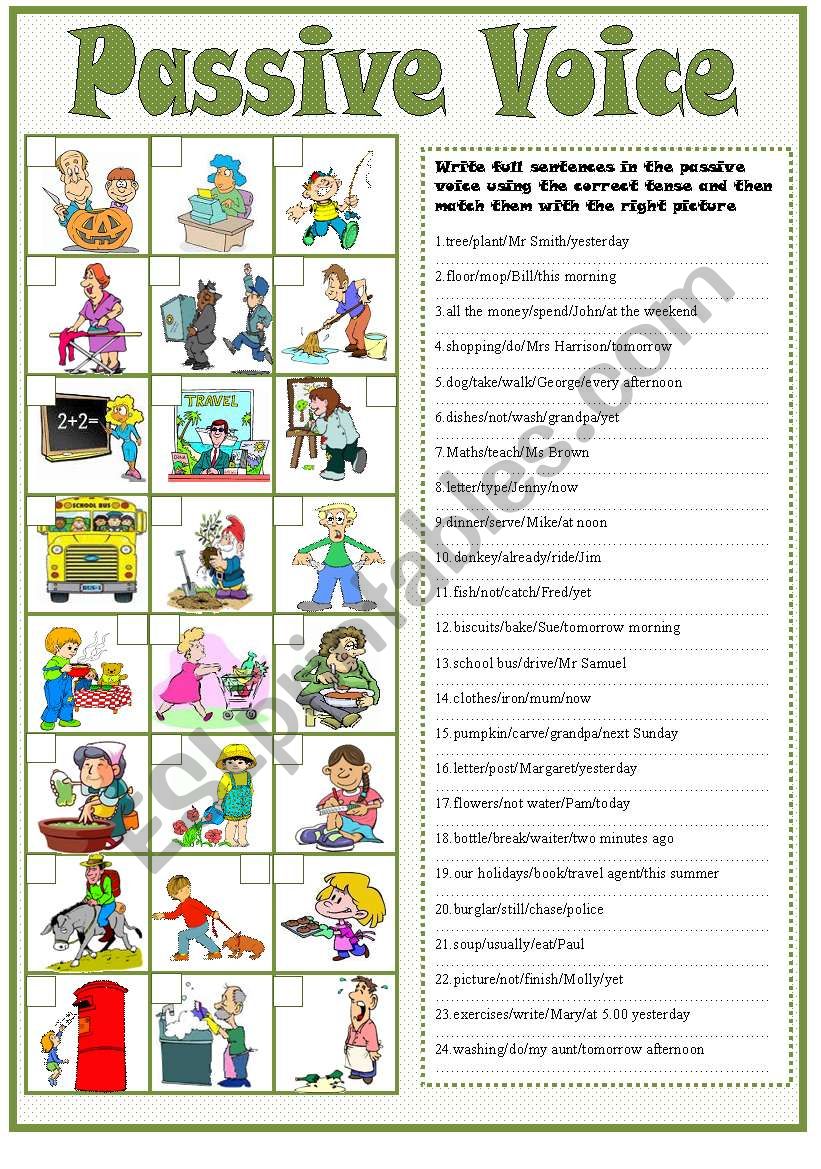
Mastering the Elusive: The Indispensable Role of Grammar Worksheets: Passive Voice
In the vast and intricate landscape of English grammar, few topics present as nuanced a challenge as the passive voice. While often misunderstood or even advised against in certain writing contexts, its mastery is undeniably crucial for comprehensive linguistic proficiency. From scientific reports and formal announcements to simply shifting emphasis in a sentence, the passive voice serves vital functions that active voice cannot always fulfill. However, for learners, grappling with its formation, appropriate usage, and subtle distinctions can be a significant hurdle. This is precisely where meticulously crafted Grammar Worksheets: Passive Voice emerge as indispensable tools, providing structured practice, clear explanations, and the repetition necessary for true understanding and retention.
The Nuance of the Passive Voice: Why It’s Both Essential and Challenging
Before delving into the merits of worksheets, it’s vital to understand why the passive voice holds such a peculiar position in English grammar pedagogy. Structurally, it’s formed using a form of the verb "to be" followed by the past participle of the main verb (e.g., "The ball was kicked by John," "The experiment will be conducted tomorrow").

Why is it essential?

- Emphasis Shift: It allows the writer to place emphasis on the action or the recipient of the action, rather than the doer. For instance, "The window was broken" focuses on the window’s state, not necessarily who broke it.
- Unknown or Unimportant Agent: When the doer of an action is unknown, obvious, or irrelevant, the passive voice is the natural choice ("Mistakes were made," "The vaccine was developed quickly").
- Formal and Scientific Writing: In academic and scientific contexts, the passive voice is frequently used to maintain objectivity and focus on processes or findings rather than individual researchers ("Data was collected," "The samples were analyzed").
- Avoiding Blame/Responsibility: Sometimes, the passive voice is used strategically to avoid assigning direct blame or responsibility ("The report was delayed").



Why is it challenging for learners?
- Transformation Complexity: Converting active sentences to passive and vice versa requires understanding verb tenses, subject-object relationships, and the correct form of "to be" plus the past participle.
- Overuse vs. Appropriate Use: Learners often struggle with when not to use the passive voice, leading to clunky or overly formal writing. They need to learn the subtle art of choosing between active and passive for clarity and impact.
- Identifying the Agent: When the agent is omitted in a passive sentence, learners might find it difficult to reconstruct the implied subject.
- Past Participle Confusion: Irregular past participles can be a source of error.



Given these complexities, a systematic and repetitive approach to learning is not just beneficial, but crucial. And this is precisely where Grammar Worksheets: Passive Voice prove their worth.

The Pedagogical Power of Grammar Worksheets: Passive Voice
Worksheets, in their essence, transform abstract grammatical rules into concrete, actionable exercises. They provide a structured environment for learners to practice, make mistakes, and correct them, solidifying their understanding through active engagement rather than passive reception.
Here’s why they are so powerful:
- Reinforcement and Repetition: Mastery in grammar, like any skill, comes from consistent practice. Worksheets offer a virtually limitless supply of varied exercises that reinforce the rules of passive voice formation across different tenses and contexts.
- Targeted Practice: A well-designed worksheet can focus on a specific aspect of the passive voice, such as transforming active sentences, identifying passive structures, or choosing the correct form of "to be." This allows learners to isolate and conquer one challenge at a time.
- Immediate Feedback (with Answer Keys): Many worksheets come with answer keys, allowing learners to check their work immediately. This instant feedback loop is incredibly powerful for self-correction and understanding where errors occurred.
- Variety of Exercise Types: From fill-in-the-blanks and multiple-choice questions to sentence transformation and error correction, worksheets can present the same grammatical concept in numerous formats, catering to different learning styles and preventing monotony.
- Diagnostic Tools: For educators, worksheets serve as excellent diagnostic tools. By reviewing completed exercises, teachers can quickly identify common errors, areas of confusion, and individual learning gaps, allowing for targeted re-teaching or intervention.
- Self-Paced Learning: Worksheets enable students to learn at their own pace. They can spend more time on challenging sections and move quickly through concepts they’ve already grasped, fostering a sense of autonomy and reducing anxiety.
- Bridging Theory and Application: While textbooks explain the "what" and "why," Grammar Worksheets: Passive Voice provide the "how." They force learners to apply the rules they’ve learned, translating theoretical knowledge into practical application.
Anatomy of Effective Grammar Worksheets: Passive Voice
Not all worksheets are created equal. The most effective Grammar Worksheets: Passive Voice are thoughtfully designed with clear learning objectives and a progression of difficulty. Here are key components and exercise types that make them invaluable:
-
Identification Exercises:
- Active vs. Passive: Learners identify whether a given sentence is in the active or passive voice. This helps build foundational recognition skills.
- Underlining Passive Verbs: Students underline the "to be" verb + past participle combination.
-
Transformation Exercises:
- Active to Passive: This is the most common and crucial exercise. Students convert active sentences into passive ones, requiring them to identify the object (which becomes the new subject), choose the correct form of "to be," and use the past participle.
- Passive to Active: Reversing the process helps solidify understanding of subject-object relationships and the role of the agent.
-
Fill-in-the-Blanks / Gap-Filling:
- Correct "to be" form + Past Participle: Students are given a sentence with a blank and a base verb, and they must correctly form the passive voice in the appropriate tense (e.g., "The letter ___ (write) last night").
- Choosing Between Active/Passive: More advanced worksheets might require students to decide whether an active or passive verb is more appropriate for the context.
-
Error Correction:
- Students identify and correct grammatical errors related to passive voice formation (e.g., incorrect "to be" verb, wrong past participle, missing agent when needed for clarity).
-
Contextualized Practice:
- Paragraph Completion: Students complete a paragraph using passive voice where appropriate, based on given cues.
- Story Rewriting: Learners rewrite a short story, changing specified sentences from active to passive or vice versa, emphasizing stylistic choices.
- Real-World Scenarios: Worksheets might present scenarios like news headlines, scientific findings, or formal announcements, asking students to construct passive sentences that fit the context. This helps learners understand when to use the passive voice, not just how to form it.
-
Sentence Combining/Building:
- Students are given multiple short sentences and asked to combine them into more complex sentences, utilizing the passive voice for better flow or emphasis.
Key Design Principles:
- Gradual Difficulty: Start with simpler sentences and tenses, then introduce more complex structures, tenses, and nuances.
- Clear Instructions: Instructions should be unambiguous and easy to follow.
- Relevant Content: Use examples that are engaging and relatable to the target age group.
- Answer Keys: Essential for self-correction and independent learning.
Integrating Grammar Worksheets: Passive Voice into the Curriculum
The true power of Grammar Worksheets: Passive Voice lies not just in their existence, but in their thoughtful integration into a broader language learning curriculum. They should not be isolated drills but rather components of a holistic approach to mastering the passive voice.
- Pre-teaching/Introduction: Use worksheets to introduce the basic structure of the passive voice after an initial explanation.
- During Teaching/Practice: Assign worksheets for homework or in-class practice after new concepts or tenses are introduced. They can be used for individual work, pair work, or even small group activities.
- Post-teaching/Assessment: Worksheets can serve as quick quizzes or formative assessments to gauge understanding before moving on to new topics.
- Writing Integration: Encourage students to apply their passive voice skills in their own writing assignments. After completing worksheets, have them revise their essays to see where the passive voice might be used effectively or where active voice would be clearer.
- Speaking Activities: While primarily written, the concepts reinforced by worksheets can be applied to speaking. For instance, students can describe a process (e.g., how paper is made, how a cake is baked) using predominantly passive voice, drawing on the structures practiced in their worksheets.
- Differentiation: Worksheets can be easily adapted to meet the needs of diverse learners. Simpler worksheets for struggling students, more complex or creative tasks for advanced learners.
Overcoming Common Challenges with Targeted Worksheets
One of the most significant challenges with the passive voice is knowing when not to use it. Many learners, once they grasp its formation, tend to overuse it, leading to vague, wordy, or stilted writing. Effective Grammar Worksheets: Passive Voice can help address this nuance.
- Active vs. Passive Choice: Worksheets can present scenarios where students must choose between an active and passive construction, prompting them to consider the intended emphasis and clarity.
- Rewriting for Clarity: Exercises that ask students to rewrite overly passive sentences into active voice, or vice versa for better effect, are crucial. This helps them develop a critical eye for stylistic choices.
- Identifying Redundant "by" Phrases: Worksheets can include sentences where the agent is obvious or unimportant and prompt students to remove the "by + agent" phrase, making the sentence more concise.
By incorporating these higher-order thinking tasks, worksheets move beyond mere mechanical drills and encourage learners to think critically about the function and impact of grammatical choices.
Conclusion
The passive voice, far from being a grammatical pariah, is an indispensable tool in the English language, offering flexibility in emphasis, objectivity, and conciseness when used appropriately. However, its mastery demands more than just theoretical understanding; it requires consistent, targeted practice. This is precisely the role fulfilled by high-quality Grammar Worksheets: Passive Voice.
These worksheets, whether print or digital, serve as the backbone of effective passive voice instruction. They provide the necessary repetition, varied exercise types, and immediate feedback mechanisms that empower learners to grasp complex structures, identify subtle nuances, and apply their knowledge with confidence. For educators, they are invaluable diagnostic and teaching aids, while for students, they offer a clear, actionable path to linguistic proficiency. Ultimately, investing time and effort into creating or utilizing well-designed Grammar Worksheets: Passive Voice is an investment in comprehensive language acquisition, equipping learners with the tools to navigate the rich complexities of English grammar with precision and flair.
